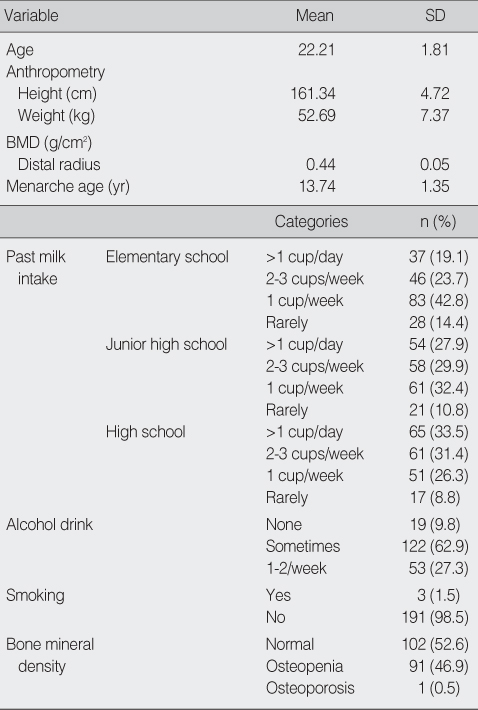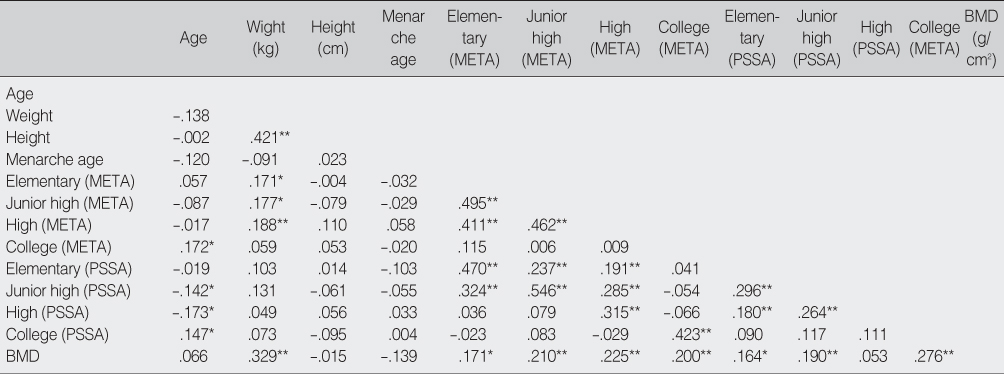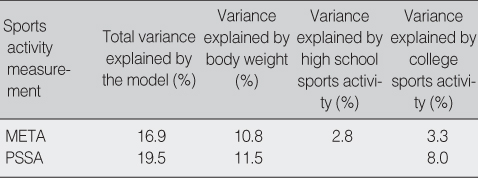Articles
- Page Path
- HOME > J Korean Acad Nurs > Volume 38(5); 2008 > Article
-
Original Article
- The Relationship between Lifetime Sports Activity Measured with MET and Peak Strain Score and Bone Measurement in College-aged Women
- Eun-Nam Lee, Eun Jung Choi
-
Journal of Korean Academy of Nursing 2008;38(5):667-675.
DOI: https://doi.org/10.4040/jkan.2008.38.5.667
Published online: October 30, 2008
1Professor, Department of Nursing, Dong-A University, Busan, Korea.
2Part-time Instructor, Department of Nursing, Dong-A University, Busan, Korea.
- Address reprint requests to: Lee, Eun Nam. Department of Nursing, Dong-A University, 1 Dongdaesin-dong 3 ga, Seo-gu, Busan 602-714, Korea. Tel: 82-51-240-2864, Fax: 82-51-240-2947, enlee@dau.ac.kr
Copyright © 2008 Korean Society of Nursing Science
- 330 Views
- 0 Download
Abstract
-
Purpose
- The aim of this study was to compare the relation between differently measured sports activities (metabolic equivalent [MET] and peak strain score) and distal radius bone mineral density in college-aged women.
-
Methods
- Lifetime sports activity was scored in two different ways: 1) a sports activity score by multiplying the intensity (METs) and duration and 2) a sports activity score by adding up physical strain scores based on the ground reaction force of each sports activities. Bone mineral density was measured using dual energy x-ray densitometry (DTX-200) in the distal radius site.
-
Results
- In stepwise multiple regression analysis, body weight and sports activities during the college period were significant positive predictors for distal radius bone mineral density. The explained variance of sports activity measured with a peak strain score (8.8%) for distal radius bone mineral density was higher than one measured with the MET score (3.3%).
-
Conclusion
- It can be concluded that sports activity scores based on MET and peak strain scores during college are very important for determining the bone mineral density in the distal radius site in women under 30.
- 1. Ainsworth BE, Haskell WL, Whitt MC, Irwin AM, Swartz AM, Strath SJ, et al. Compendium of physical activities: An update of activity codes and MET intensities. Medicine and Science in Sports and Exercise. 2000;32:S498–S516.ArticlePubMed
- 2. Augestad LB, Schei B, Forsmo S, Langhammer A, Flanders WD. The association between physical activity and forearm bone mineral density in healthy premenopausal women. Journal of Women's Health. 2004;13:301–313.Article
- 3. Bailey DA, McKay HA, Mirwald RL, Crocker PR, Faulkner RA. A six-year longitudinal study of the relationship of physical activity to bone mineral accrual in growing children: The university of Saskatchewan bone mineral accrual study. Journal of Bone and Mineral Research. 1999;14:1672–1679.ArticlePubMedPDF
- 4. Byun YS, Kim OS. Life style and self-efficacy in osteoporosis women. Journal of Korean Academy of Nursing. 1999;29:530–540.
- 5. Byeon YS. Difference of bone density and risk factors related to osteopenia of young women in their twenties. Journal of Korean Academy of Adult Nursing. 2006;18:790–797.
- 6. Fehily AM, Coles RJ, Evans WD, Elwood PC. Factors affecting bone density in young adults. American Journal of Clinical Nutrition. 1992;56:579–586.ArticlePubMed
- 7. Ford MA, Bass MA, Turner LW, Mauromoustakos A, Graves BS. Past and recent physical activity and bone mineral density in college-aged women. The Journal of Strength and Conditioning Research. 2004;18:405–409.ArticlePubMed
- 8. Friedenreich CM, Courneya KS, Bryant HE. The lifetime total physical activity questionnaire: Development and reliability. Medicine and Science in Sports and Exercise. 1998;30:266–274.ArticlePubMed
- 9. Greendale GA, Huang MH, Wang Y, Finkelstein JS, Danielson ME, Sternfeld B. Sport and home physical activity are independently associated with bone density. Medicine and Science in Sports and Exercise. 2003;35:506–512.ArticlePubMed
- 10. Groothausen J, Siemer H, Kemper HC, Twisk JW, Welten DC. Influence of peak strain on lumbar bone mineral density: An analysis of 15-year physical activity in young males and females. Pediatric Exercise Science. 1997;9:159–173.Article
- 11. Jung HY. Comparative analysis of body mass index and body mineral density of female college students at their 20's according to the existence of physical exercise. 2004;Seoul, Ewha Womans University. Unpublished master's thesis.
- 12. Kemper HC, Twisk JW, van Mechelen W, Post GB, Roos JC, Lips P. Fifteen-year longitudinal study in young adults on the relation of physical activity and fitness with the development of the bone mass: The Amsterdam growth and health longitudinal study. Bone. 2000;27:847–853.ArticlePubMed
- 13. Kim MH, Kim JS. The relationship between body composition and bone mineral density in college women. Journal of Korean Academy of Nursing. 2003;33:312–320.ArticlePubMedPDF
- 14. Lanyon LE. Control of bone architecture by functionalload bearing. Journal of Bone and Mineral Research. 1992;7:S369–S375.PubMed
- 15. Lanyon LE. Using functional loading to influence bone mass and architecture: Objectives, mechanisms, and relationship with estrogen of the mechanically adaptive process in bone. Bone. 1996;18:S37–S43.Article
- 16. Lee EN, Clark MK. Influence of lifetime sports activity based on ground reaction force on the bone mineral density in Korean adults. Journal of Korean Academy of Nursing. 2005;35:621–630.PubMed
- 17. Mazess RB, Barden HS. Bone density in premenopausal women: Effects of age, dietary intake, physical activity, smoking, and birth-control pills. American Journal of Clinical Nutrition. 1991;53:132–142.ArticlePubMed
- 18. McCulloch RG, Bailey DA, Houston CS, Dodd BL. Effects of physical activity, dietary calcium intake and selected lifestyle factors on bone density in young women. Canadian Medical Association Journal. 1990;142:221–227.PubMedPMC
- 19. Slemenda CW, Hui SL, Longcope C, Wellman H, Johnston CC Jr. Predictors of bone mass in perimenopausal women. A prospective study of clinical data using photon absorptiometry. Annals of Internal Medicine. 1990;112:96–101.PubMed
- 20. Tabachnick BG, Fidell LS. Using multivariate statistics. 1989;New York, NY, Harper Collins.
- 21. World Health Organization. Assessment of fracture risk and its application to screening for postmenopausal osteoporosis. WHO technical report series 843. 1994;Geneva, WHO.
REFERENCES
Figure & Data
REFERENCES
Citations

Baseline Characteristics of the Subjects (N=194)
BMD=bone mineral density.
MET, PSS and Duration of Sports Activity according to Period (N=194)
MET=metabolic equivalent; PSS=peak strain score.
Correlation between Variables and Bone Mineral Density
*p<.05; **p<.01.
META=activity level based on MET score; PSSA=activity level based on peak strain score; BMD=bone mineral density.
Comparison of Variance in Bone Mineral Density explained by Physical Activity Measured with META and PSSA
META=Activity level based on MET score; PSSA=Activity level based on peak strain score.
BMD=bone mineral density.
MET=metabolic equivalent; PSS=peak strain score.
*p<.05; **p<.01. META=activity level based on MET score; PSSA=activity level based on peak strain score; BMD=bone mineral density.
META=Activity level based on MET score; PSSA=Activity level based on peak strain score.
 KSNS
KSNS
 E-SUBMISSION
E-SUBMISSION




 Cite
Cite

